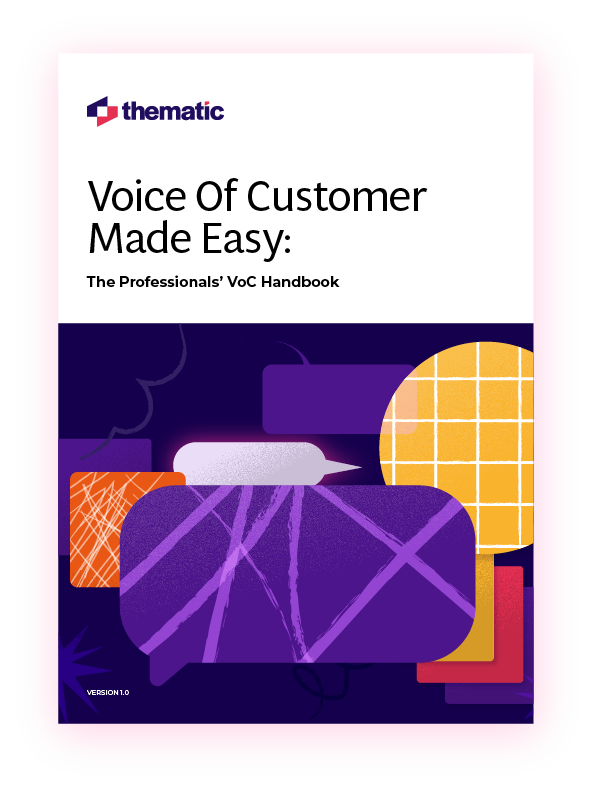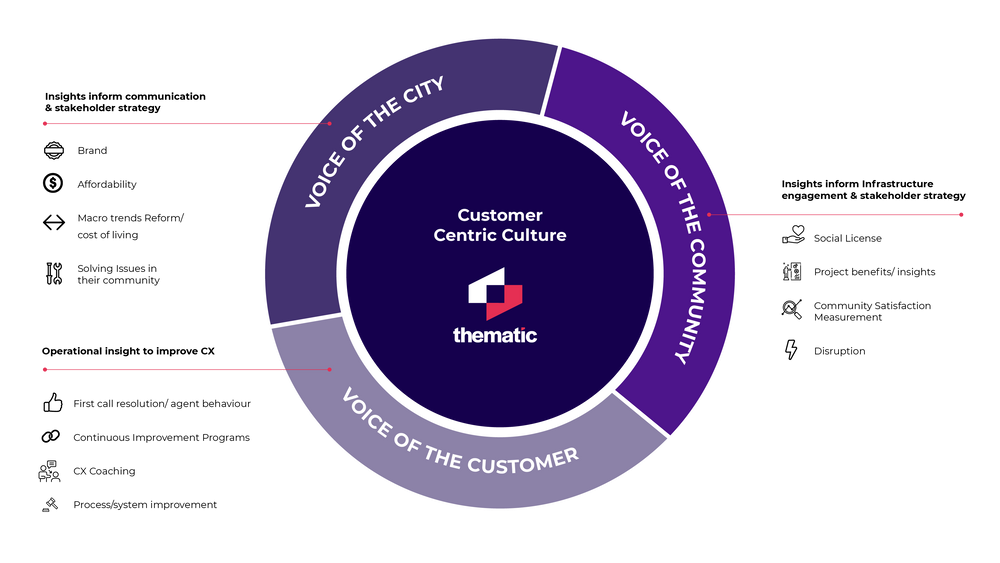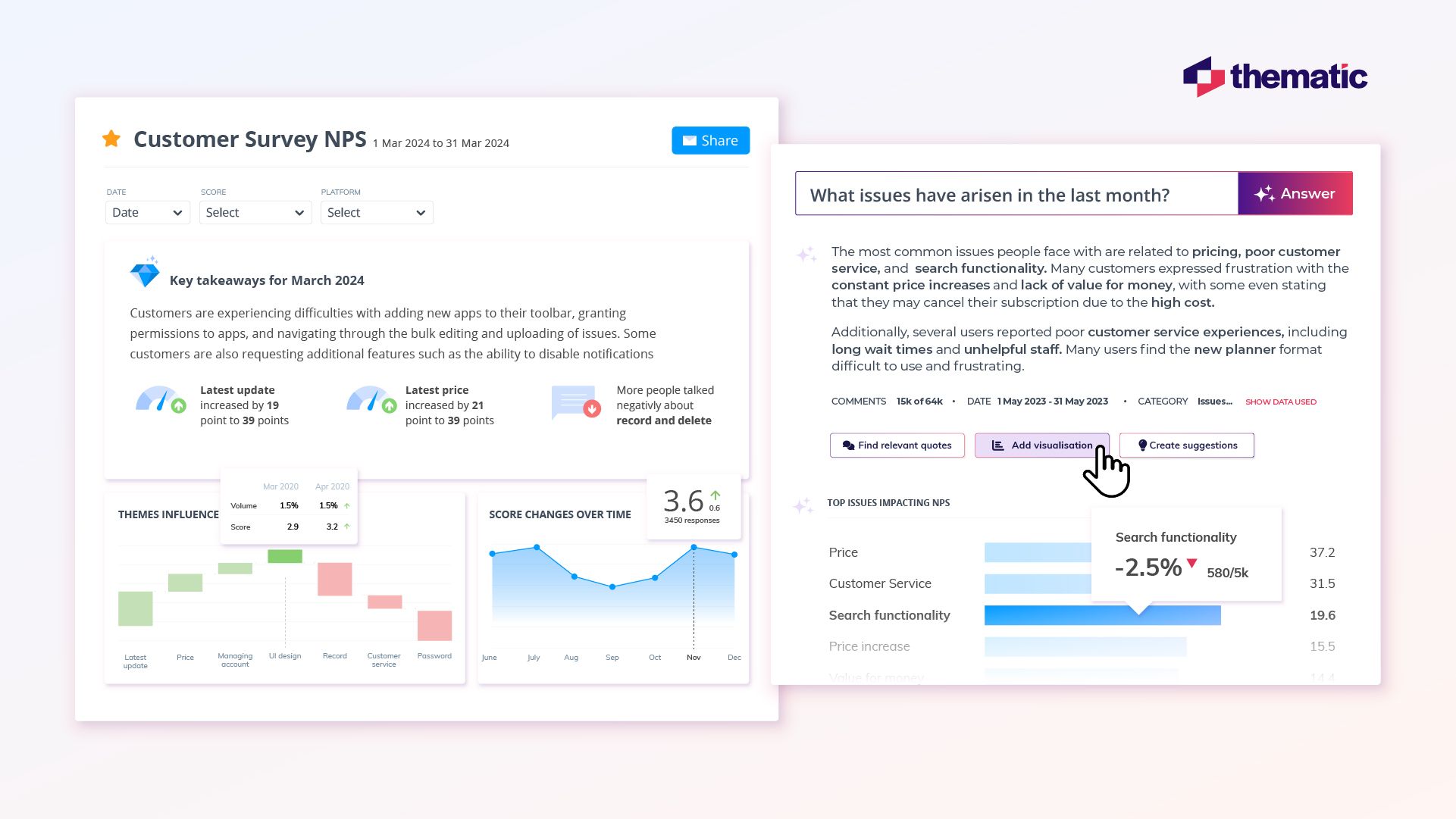
In this guide, we'll walk you through 8 clear steps to build a VoC strategy that not only listens but leads.

Imagine knowing exactly what your customers think, feel, and desire, and using that knowledge to stay ahead of your competition. Many businesses overlook their most valuable resource: customer feedback. Understanding the true voice of your customers can be the difference between standing out or getting lost in the crowd.
Research by the Aberdeen Group found that companies with a high-quality VoC strategy saw almost 10 times annual revenue growth due to higher customer retention. A robust Voice of the Customer (VoC) strategy is no longer optional. It's essential for driving loyalty, refining your offerings, and boosting your bottom line.
By actively listening and strategically acting on customer insights, you can transform feedback into powerful business growth. In this guide, we'll walk you through 8 clear steps to build a VoC strategy that not only listens but leads.
Short on time? Skip straight to the 8 steps to build a Voice of Customer strategy.
A Voice of Customer (VoC) strategy is the process of gathering customer feedback and using that information to shape future decisions. It helps evaluate your current business objectives and understand what your customers really want. By incorporating this feedback, businesses can increase customer satisfaction, boost loyalty, and drive long-term success.
Collect insights from customers using various channels, such as surveys, interviews, social media, and online reviews. Utilizing multiple sources ensures a comprehensive understanding of customer sentiment across different touchpoints.
Use tools like sentiment analysis, AI, and text analytics to interpret the feedback data. This step transforms raw data into actionable insights, highlighting patterns and areas that need improvement.
Not all feedback is equally important. Focus on the key areas that drive customer satisfaction and differentiate your business. Prioritize based on factors like customer impact, frequency of mention, and alignment with business goals.
Show customers that their voices are heard by implementing changes that address their concerns. This builds trust and demonstrates your commitment to improving their experience based on their input.
A successful VoC strategy involves everyone from frontline employees to executives. Create a unified, company-wide approach that encourages cross-departmental collaboration to elevate the customer experience.
The last two points are crucial for the success of your VoC strategy. Despite the fact that 95% of companies gather customer feedback, only 10% actively use these insights to make meaningful improvements.
Written by a CX expert, this handbook simplifies VoC strategies and helps you get the most from customer feedback.
What's inside:

A well-executed VoC strategy enables businesses to better understand and meet customer expectations. By actively listening to feedback and making changes, companies can address pain points and provide a more seamless, enjoyable experience. This leads to higher customer satisfaction, which directly impacts loyalty and retention.
Research by Salesforce shows that 80% of customers view the experience a company provides as equally important as its products and services. By implementing VoC strategies that pinpoint and address customer pain points, businesses can significantly enhance their service quality, ultimately boosting customer satisfaction.
When customers feel heard and see that their feedback drives change, they are more likely to remain loyal to the brand. A VoC strategy builds trust and long-term relationships, increasing customer retention and reducing churn. Studies by Bain & Company show that improving customer retention by just 5% can increase profits by 25%
The Aberdeen Group study cited earlier showed that companies with a strong VoC program enjoy 55% greater customer retention rates compared to those without. By acting on feedback, companies demonstrate to customers that their opinions matter, which fosters long-term loyalty and reduces churn.
By tapping into customer feedback, businesses can uncover unmet needs or new market opportunities. VoC data provides insights that can guide product development, service enhancements, and even new offerings, ensuring the business stays ahead of competitors and aligns with customer desires.
Companies like Apple and Tesla have famously incorporated customer feedback into their product development cycles. Apple’s focus on user-friendly design and Tesla’s continuous software updates based on customer suggestions highlight how VoC can drive innovation and maintain industry leadership.

A VoC strategy transforms subjective customer feedback into actionable data that can drive strategic decisions. This enables companies to prioritize resources and investments in areas that have the greatest impact on customer satisfaction and business growth. Data-driven decisions reduce guesswork and increase operational efficiency.
Research by Deloitte found that customer-focused companies are 60% more profitable than companies that aren’t. VoC strategies provide the data necessary to make informed, customer-centric decisions that enhance efficiency and profitability across departments.
Companies that effectively implement VoC strategies stand out in a crowded marketplace. With many businesses still failing to act on customer insights, those that do can build a strong competitive edge by continually refining their customer experience based on real-time feedback.
Research by Bain & Company shows that companies that excel at customer experience grow revenues 4-8% above their market average. By continuously adapting and improving based on customer feedback, businesses can outperform competitors who neglect or fail to act on these insights.
Now we’ve covered the reasons why you should develop a clear VoC strategy, let’s look at the practical steps you can take to get started:
Before you launch your VoC program we recommend you first establish clear objectives. Determine what you aim to achieve with customer feedback. This will help guide your program’s focus and help measure its success.
Your goals will differ depending on your business priorities. Here are some examples of what you might aim to achieve with your Voice of Customer strategy:
To help you get started, here’s a list of questions we recommend asking before you start your VoC program. Remember that different parts of your organization may have different requirements, so try to include a variety of perspectives in your research.
Let’s take a closer look at defining your VoC objectives. Here at Thematic we recently worked with New Zealand’s largest utility company, Watercare. At the time Watercare found themselves in a customer service crisis after severe storms in the region.
Customers were especially frustrated by unresolved issues and repair processes after the storms. So Watercare decided to establish a VOC program to find out exactly what they needed to do to increase customer satisfaction.
They chose to use Thematic’s AI analytics software to mine their feedback data for insights. Thematic’s software enabled them to see the main themes in their customer data. The Watercare team could then focus on fixing these specific issues rather than constant fire-fighting.

Engaging the right stakeholders is crucial for the success of your Voice of the Customer strategy. Start by identifying which teams and individuals within your organization are most invested in the program’s outcomes.
Be sure to pinpoint specific colleagues and determine the appropriate level of involvement each will need to ensure alignment and effective execution.
It’s a good idea to include stakeholders from across the organization from the earliest days of your VoC strategy. That way you can get as much feedback as possible and shape the program collaboratively.
Product Team: Responsible for integrating customer feedback into product development, ensuring features and offerings align with customer needs.
Marketing Team: Uses VoC insights to refine messaging, positioning, and campaigns that resonate with target audiences based on real customer sentiments.
Sales Team: Benefits from a deep understanding of customer pain points and preferences, enabling more effective sales pitches and relationship-building strategies.
Customer Success/Support: Leverages VoC data to improve customer satisfaction, address concerns proactively, and reduce churn by tailoring support.
Senior Leadership: Provides strategic oversight, ensuring that VoC insights are aligned with long-term business goals and driving top-down support for the initiative.
Finance Team: Analyzes the financial implications of VoC-driven changes, helping to prioritize investments that will deliver the most ROI based on customer feedback.

The next step is all about your customer. Think about every stage of the customer journey from their first interaction with your brand to post-purchase support.
Mapping out this journey helps you understand the different touchpoints where customers interact with your business. That could be through your website, customer service, social media, or in-store visits.
A solid VoC strategy should gather feedback from every type of customer interaction to really understand the full experience. Focusing on multiple touchpoints gives you a clearer picture of what’s working and where things could improve.
Identify which customer segments you want to hear from, whether it’s new customers, loyal ones, or those who have already left. Define these groups by their strategic value and commercial appeal. Make sure that you can identify them in your data, as this is fundamental for a successful VoC program.
There are so many VoC tools currently on the market that can help streamline your program. Here are a few types of tools you could use:
VoC survey tools are a popular way to collect customer feedback through surveys, questionnaires, and polls. By asking targeted questions, businesses can gain specific insights into customer preferences and satisfaction to inform actionable strategies.
Here’s some examples of popular VoC survey tools:
VoC social listening tools monitor social media, forums, and review sites to capture real-time customer sentiment. They help businesses understand how customers feel about their brand, identify trends, and engage directly with customer feedback.
Here are a few social listening tools:
Integrated VoC platforms bring together different data sources for a complete view of the customer experience. By combining data from surveys, social media, and customer support, these platforms provide a comprehensive understanding of customer sentiment and behavior.
This holistic approach helps businesses make informed decisions based on diverse customer feedback. Yet since they focus on doing everything in one platform, these types of platforms can be limited when it comes to analytics. Organizations that require more advanced analytics capabilities might want to consider dedicated AI analytics tools like Thematic.
Popular integrated platforms for VoC programs include:
Advanced VoC analysis tools use AI and machine learning to deepen and refine customer insights. They quickly process large amounts of qualitative data, spotting patterns and trends that traditional methods might miss.
With these advanced analytics, businesses can better predict customer expectations, personalize experiences, and continually enhance their VoC initiatives.
AI tools like Thematic are a great option since they automatically analyze your feedback and determine the main themes and sub-themes in your customer data. Thematic also performs sentiment analysis so you know exactly how your customers are feeling.

Why not try out Thematic on your data with a free guided trial and see how it works for you.
Choosing the right methods for your VoC program goes hand-in-hand with the tools you select. You will want to choose methods that align with your goals and make sense for your customers.
Think about how your customers prefer to interact with you. That could be via social media, email, or an app. Each channel will provide different opportunities and flavors of feedback. For example, data from social media could give you more natural feedback while survey responses can be formal and structured.
Customer demographics can also play a role in your choices. Millennials and Gen Z customers may prefer social media listening and mobile surveys, while older customers might respond better to phone interviews or email surveys.
Collecting quality customer feedback is essential for VoC success. Consider how you will gather and integrate all of your data in one place to make it easy to extract insights.
Your customer feedback will likely come in through many channels:
Surveys provide structured insights that are easy to analyze. Focus on asking clear, targeted questions that address specific aspects of the customer experience, such as satisfaction, preferences, and pain points.
We recommend incorporating other relevant data sources like social media feedback, online reviews, customer support interactions, and any other touchpoints where customers express their opinions. Each data source can provide unique insights, enriching your overall understanding of customer sentiment.
As your VoC program progresses, think about how you'll collect and integrate this data effectively. Consider using VoC tools that allow for seamless data aggregation and analysis, making it easier to identify trends and draw actionable conclusions.
Regularly review and adjust your customer tools to ensure they remain relevant and effective. The goal is to keep the lines of communication open with your customers.
You likely have a variety of feedback types, such as customer complaints, surveys, online reviews, and chat conversations. To get a complete view of your customers, it’s crucial to analyze each data channel consistently. This unified approach helps you identify key concerns and preferences across different touchpoints.
Using AI-powered tools can streamline this process. Advanced AI excels at interpreting human language, making it perfect for converting unstructured data into actionable themes. Best practices include spotting patterns, creating codes, and developing a taxonomy to transform qualitative feedback into quantifiable insights.
Thematic has lots of unique features that make it a great choice for analyzing your VoC feedback. Here’s how Thematic can enhance your VoC program:
First you’ll want to connect your customer feedback channels to Thematic. Thematic offers a wide range of ready-made integrations, ranging from Zendesk and Medallia to Trustpilot and Intercom.
2. Explore your themes
Thematic automatically identifies themes in your data in real-time. They are divided into themes and sub-themes so you can easily see which topics are most important to your customers. You can easily track specific themes across all your data sources and see how they change over time.
3. Modify your themes
Thematic gives you total control over your themes. You can modify or delete themes and sub-themes to match your business goals. This is great if you want to focus on particular topics for your VoC program. Why not try out Thematic on your data with a free guided trial and see how it works for you.
Now that you have gathered all these valuable insights, it’s time to translate them into concrete actions.
At this point you will probably have more insights than you can use. Begin by prioritizing your insights based on their potential impact on customer experience. Consider which areas need immediate attention and which initiatives can provide quick wins.
Thematic’s built-in sentiment analysis can help you identify which issues are impacting NPS scores the most so you can fix them fast. For example, if negative feedback highlights a common complaint about a product feature, like “log in issues”, focus on making improvements in that area first.
Next, involve cross-functional teams in brainstorming sessions to develop creative solutions. This collaborative approach can lead to innovative ideas that enhance the overall customer experience.
For instance, if surveys indicate customers desire more personalized service, you might create a training program for your customer support team to help them engage more effectively with customers.
The last step is the most important. Your organization needs to take action on the valuable insights you’ve uncovered in your VoC strategy. The best way to do that is by preparing a compelling presentation for key stakeholders that inspires action.
Consistently sharing your VoC insights across teams is key to keeping everyone on the same page, especially teams like marketing, operations, and customer service who need to act on those findings.
To get the most out of your VoC data, ensure it’s as accessible as possible. Think about how non-technical teams like customer service representatives, senior leadership, or finance might view it. What would help them easily understand your insights and move forward with action or approve future VoC initiatives?
We suggest using simple dashboards or easy-to-understand data visualizations to present your findings. Tools like Thematic, which uses AI analysis, are great for keeping all your insights in one place and making them easy for everyone to access and use.

A strong Voice of Customer (VoC) strategy can be a game-changer. It boosts customer satisfaction and loyalty, fuels innovation, and gives your business a competitive edge. By truly listening to what your customers are saying, you’re creating a cycle of trust and growth that benefits both your company and your customer relationships.
But here’s the catch: a VoC strategy isn’t a one-and-done deal. Customer expectations are always evolving so your approach needs to be just as dynamic. Keep the feedback loop open, adapt to new insights, and never stop refining your strategy. In doing so, you’ll stay ahead of the curve and continue to deliver experiences that keep your customers coming back.
Ready to get started? Why not try out Thematic on your customer data and see for yourself why so many companies use us for their customer programs.
Written by a CX expert, this handbook simplifies VoC strategies and helps you get the most from customer feedback.
What's inside:

Join the newsletter to receive the latest updates in your inbox.